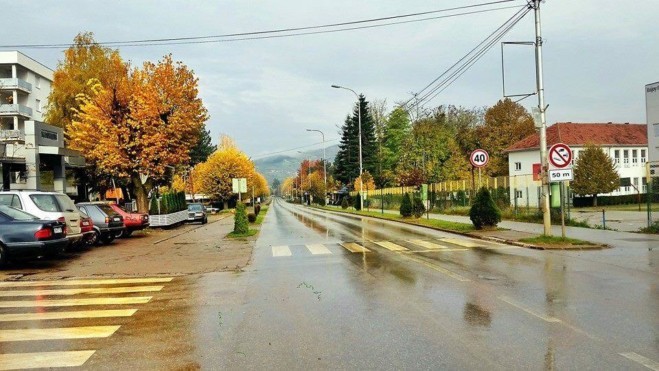Faruk Krasniqi, a 22-year-old from Kamenica, says that when he was 16 he started to work to gain money for his own needs. Even though he finished sociology studies at the University of Prishtina, he was disappointed that he was not able to find a job. Now, he carries wood for heating in return for some money.
Faruk thinks that nowadays you can have a job only if you are “part of the leading politic party.”
“Every day, the intention of the Kamenica`s youth to flee is evident. A great number of my friends have already gone. Even those who are still here have the same intention. Me too, I`m just waiting to see if there will be any change in my city`s leadership. If not, I will move to Prishtina since there I will have more opportunities,” he hopes.
He remembers Kamenica some years ago as a city that even had a night life. Both discos were visited by youth not only from Kamenica, but from other cities as well, which used to give life to the city. According to him, today only a small number of elder people are seen at coffee shops, usually from a morning coffee. The atmosphere in the city changes only during summer, when the Diaspora come for vacations.
According to a document prepared in 2007 by the Institute for Spatial Planning and the Municipality, there were 57,000 inhabitants in Kamenica. The registration of the population in 2011 showed that the number of the population had decreased by 12,000.
At present, Kamenica has 36,000 inhabitants. The main factor for the constant decreasing number of inhabitants in this municipality is the number of births, and the decreasing number of pupils in primary and high schools is an example of this.
From January until the end of August 2017, there were only 18 births in Kamenica. Seven years ago, the number of births throughout the year was more than 450.
There were 786 pupils in “Ismail Qemali” primary school in Kamenica five years ago. The trend of decreasing is not stopping: at present, there are only 485 pupils, 51 less than in 2016.
Shaban Ajvazi, the secretary of this gymnasium, recalls the time when there were 35 pupils in a classroom. Now, there are some classrooms with only 15 pupils.
“This year alone, five pupils left school because their families moved from here. Four of them moved to Prishtina and one to Gjilan,” he explains.
He says that in the municipality of Kamenica, lack employment opportunities and poverty is being spread and that`s why many youngsters are getting married to people from western countries, or they move to other cities.
On a one-day visit to the city of Kamenica, this reporter had conversations with many youngsters of the city, and learned that a considerable number of youngsters have quit their studies, saying that spending money on education is in vain. One of the reasons was that “after finishing studies, they are seen as the same as those who only have a high school diploma.”
One youngster, Fatlum Maliqi, a 22-year-old from Bustava, a village of Kamenica, quit his studies. He was studying law at “Iliria” University in Prishtina. He told KosovaLive that the day after he quit he planned to travel to Kazakhstan to work for a year, hoping to improve the economic situation of his family.
Even though he is leaving Kosovo against his will, the economical conditions and the impossibility of getting a job made him look to moving to another country as a solution.
“I do not have hope anymore and that`s why when I come back I will look for any other possibility to live outside the country,” Fatlum says.
According to the data of the Municipality, in the last two years, 475 people have emigrated either inside or outside Kosovo and 95 of them even gave up their Kosovar nationality.
The municipality of Kamenica has mainly been known for its construction materials industry, ceramics and mining for sinter magnesia. But there also are favorable conditions for agriculture, farming, bee-keeping, growing fruits, doing crafts, trainge etc.
According to the statistics of the municipality, there are 1,362 employees in the public sector, mainly older adults. Youth can be seen only working in coffee shops, restaurants or markets.
Valdrinë Pireva, a 22-year-old from Kamenica who is about to finish her psychology studies at the College “Fama” in Gjilan, has been working at “Driloni” market for some time now.
She says she has no motivation to take the book and study for her exams since she thinks she will not be able to achieve anything in her town. Valdrina says that lack of youth opportunities is forcing many families to have their daughters marry at an early age, and tells about some girls who recently married by the age of 17 or 18.
“I would not live in Kosovo if I were to be asked. I want to go as far as possible from Gjilan and Kamenica… I hope to have an opportunity to go outside Kosovo, at least that my descendents will not face the same problem. Initially so they do not lack motivation to study and for several other reasons…”, she says.
Gazmend Berisha, 22 years old, who graduated from the Department of History at University of Prishtina and during his studies worked as a waiter, shares the opinion as well.
Even now he works as a waiter, convinced that the possibility to get a job in his profession is very low, almost impossible.
“I hope that in the near future there will be some change, since Kamenica has very skillful youth who deserve a lot,” Gazmend says.
If in the meantime there is not any job possibility, he will try to create a life in Prishtina or even outside Kosovo.
Even though he accepts that many youngsters from Kamenica left, the vice-mayor of the municipality of Kamenica, Valon Maliqi, says that the main reason for people leaving is due to the lack of investing in Kamenica after Kosovo-Serbia war. According to him, this demotivates the citizens to continue their life in their hometown.
“This is why any citizen who gets the possibility to leave the country, will do it,” Maliqi says.
Nafie Sylejmani








